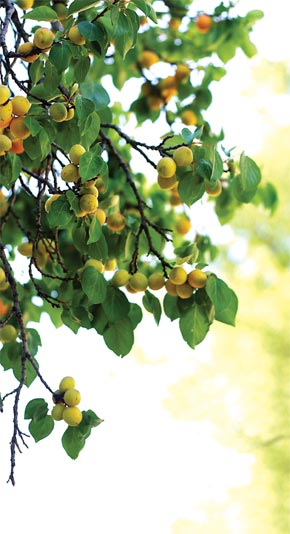
Q. Can I prune a six-inch diameter branch off my apricot tree? I’m making room for a garden shed, but I could wait if it would harm the tree.
A. It’s perfectly okay at this time to remove a limb(s) and or branches off an apricot tree. Actually, you could do your dormant season pruning now. Traditionally, January and February have been the customary months to prune deciduous fruit trees; however, this is changing particularly with apricots. There is a lot of discussion supporting the summer and fall pruning of fruit trees. This also includes cherries, plums, peaches and nectarines. The exception would be those varieties with a crop still maturing such as apples, pears and persimmons.
September and October are excellent months to prune as the trees are in the beginning stages of dormancy, even though the leaves haven’t turn color and started to fall. Leaf drop is still four to six weeks off. By definition, plants, including evergreens, are dormant when they have stopped actively growing. This is certainly the case with fruit trees as we haven’t seen any new growth on deciduous varieties for sometime nor do we expect to see any until next spring. One of the biggest disadvantages of pruning now is that the foliage gets in the way. It’s more difficult to identify what needs to be prune and or kept. The trade off is that during the winter months, conditions can be cold, damp, muddy or all of the above. Hence pruning in the fall is gaining in popularity.
Pruning apricot trees during the winter months can be problematical during wet damp periods. Apricots are susceptible to an air-borne disease called Eutypa that enters through the fresh pruning wound(s). The disease causes a sudden die back of the limbs and branches in the canopy during late spring or summer. Unfortunately, this disease has no chemical treatments. Once the wound(s) have callus over, it’s no longer a threat. The callusing takes a couple of days to occur. You’ll need a five-day period of dry weather to prune and mother nature doesn’t always co-operate. You avoid the problem altogether by pruning in the late summer or fall. Eutypa is often confused with root rot, as the symptoms are very similar, dieback in the canopy. Fortunately, the two diseases occur at different times of the year. With root rot, twigs, stems, and branches in varying sizes fail to break dormancy or leaf out. The problem could be spread out throughout the canopy or in one section. In addition, it isn’t uncommon the entire tree to leaf out and then have an area(s) where the foliage collapses, wilts and then dies with the first warm spell. These are all indicators of root rot. A major contributor to root rot is over watering during the summer and fall. A mature apricot should be watered once every fourteen to twenty-one days after the rainy season end and discontinue watering altogether after Labor Day. And finally, planting under the canopy of apricots, peaches, nectarines, plums and cherries is discouraged.
Leave a Reply